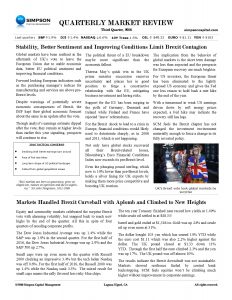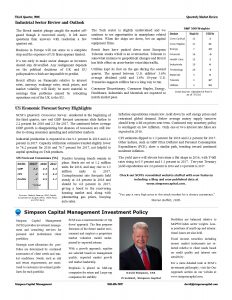SCM’s Quarterly Consensus Survey, conducted at the beginning of the third quarter, saw real GDP forecast consensus slide further to 2.2 percent for 2016 and 2.3 for 2017. The continued below average GDP growth is disappointing but chances of recession are still low due to strong consumer spending and solid labor markets.
Industrial production is expected to rise 0.1 percent in 2016 and 2.0 percent in 2017. Capacity utilization estimates trended slightly lower to 76.2 percent for 2016 and 76.7 percent for 2017, spurring capital spending on Tech products.
Positive housing trends remain in place. Starts are set at 1.2 million units for 2016, and may rise to 1.3 million units in 2017. Unemployment rate forecasts held steady at 4.8 percent in 2016 and should be 4.6 percent in 2017, giving a boost to the recovering housing market and, along with plummeting gas prices, buoying auto sales.
Inflation expectations remain low, held down by soft energy prices and restrained global demand. Below average money supply turnover should keep a lid on prices near term. Continued easy monetary policy is contingent on low inflation. Only one or two interest rate hikes are expected in 2016.
CPI estimates dipped to 1.3 percent for 2016 and 2.2 percent for 2017. Other indices, such as GDP Price Deflator and Personal Consumption Expenditures (PCE), show a similar path, trending toward continued moderate inflation.
The yield curve will elevate but retain a flat shape in 2016, with T-bill rates rising to 0.5 percent and 1.1 percent in 2017. Ten-year Treasury yield expectations are 2.0 percent in 2016 and 2.4 percent in 2017.
SCM Forecast Survey Summary
| Series Name | 15 Ann | 16 Ann | 17 Ann |
| Nominal GDP | 17953.50 | 18554.75 | 19348.75 |
| Nominal GDP Chg % | 3.46 | 3.66 | 4.25 |
| Real GDP | 16433.66 | 16805.33 | 17222.00 |
| Real GDP Chg % | 2.44 | 2.18 | 2.34 |
| Industrial Prod Index | 107.30 | 106.00 | 108.10 |
| Industrial Prod % | 1.45 | 0.12 | 2.00 |
| Capacity Utilization | 77.90 | 76.15 | 76.70 |
| Housing Starts | 1.11 | 1.19 | 1.29 |
| Total Vehicle Sales | 17.43 | 17.33 | 17.06 |
| Real Disposable Inc | 12219.00 | 12572.00 | 12861.00 |
| Real Dispos Inc Chg % | 3.43 | 2.93 | 2.30 |
| Unemployment Rate | 5.10 | 4.80 | 4.56 |
| Corporate Profits | 1538.70 | 1424.10 | 1498.00 |
| Corp Profits Chg % | -0.70 | 2.45 | 1.70 |
| Consumer Price Index | 237.05 | 240.60 | 245.95 |
| CPI Chg % | 0.24 | 1.26 | 2.24 |
| GDP Price Index | 109.63 | 111.03 | 113.05 |
| GDP Price Deflator | 1.02 | 1.45 | 1.90 |
| Personal Consump Exp | 109.30 | 111.00 | 113.00 |
| PCE Chg % | 0.58 | 1.20 | 1.94 |
| PPI Chg % | -0.90 | 0.60 | 2.20 |
| Crude Oil WTI | 48.70 | 37.00 | 45.15 |
| Prime Rate | 3.32 | 3.60 | 4.20 |
| Fed Funds Target | 0.20 | 0.49 | 1.01 |
| Treasury Bill | 0.06 | 0.45 | 1.11 |
| LIBOR 3 mo | 0.31 | 0.69 | 1.12 |
| 2 Yr Treasury Note | 0.69 | 0.71 | 1.14 |
| 5 Yr Treasury Note | 1.52 | 1.13 | 1.43 |
| 10 Yr Treasury Bond | 2.16 | 2.04 | 2.39 |
| Aaa Corp Yields | 3.91 | 3.95 | 4.27 |
| Baa Corp Yields | 4.99 | 5.16 | 5.50 |
Sources: BMO Capital, Congressional Budget Office, Federal Reserve, PNC Economics and Wells Fargo




